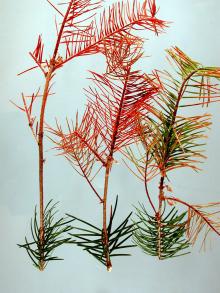Cause Dermea boycei (asexual: Faveostroma boycei) and Diaporthe lokoyae (asexual: Phomopsis lokoyea), fungi. Cankers are most often found on trees that are not vigorous or are weak from drought or winter injury, typically 1 to 2 years after the stress. Infections are on new shoots from windblown spores. Mechanical injuries can also be sites for new infections. Dermea boycei has been generally found on young trees of Douglas-fir and grand fir.
Sclerophoma sp. have been obtained from cankers a few times by the OSU Plant Clinic.
Symptoms The sunken Dermea cankers are elliptical and vary in size. Larger cankers can be up to 30 inches long. They develop through the dormant season. Branches and stems can be attacked. When the canker has girdled the stem or branch, the portion above is killed. Tiny black pycnidia appear on sunken cankers in the bark.
Symptoms of Phomopsis canker were mainly dieback in the upper crown and stem cankers at the bases of killed branches. Dieback can be as much as 15 to 20 ft. Small regeneration trees can also be top-killed. During the winter, lesions up to 6 ft in length and 1 to 2 inches wide develop downward from the killed top.
Cultural control
- Use cultural practices that favor good plant growth.
- Pruning out the canker below the infected area helps reduce inoculum levels.
Chemical control
- Fungisol is registered as a tree injection for Phomopsis canker. Trees are to be injected as a preventive treatment. Do not inject trees less than 2 inches in diameter or that are suffering from various stresses. Washington and Idaho only.
Reference Funk, A. 1968. Diaporthe lokoyae n. sp., the perfect state of Phomopsis lokoyae. Canadian Journal of Botany 46:601-603.



